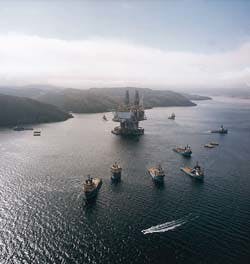WATCHING GOVERNMENT
A nine-tug flotilla late last month began towing the 600,000-metric ton Hibernia concrete production platform from harbor in Newfoundland to the Grand Banks wellsite. The 196-mile trip of the 735-ft structure is expected to take as long as 9 days at about 30 miles/day, depending on weather. The platform is the key element in the $5.8 billion (Canadian) project to produce oil from Hibernia oil field (see Watching Government, facing page). A support vessel towed a small iceberg out of the way as the flotilla left the sheltered waters of Trinity Bay. The unit was anchored in the bay after onshore construction at Bull Arm. Reconnaisance flights indicated few icebergs in the Grand Banks area but some closer inshore. Icebergs will be towed out of the way or detoured around, if necessary. When the platform reaches its field location, it will be lowered to the seabed and ballasted with 400,000 tons of iron ore. Drilling is scheduled to begin Aug. 15, with initial production in December. Hibernia partners include Petro-Canada, Mobil Oil Canada Ltd., Chevron Canada Ltd., and Murphy Oil Ltd.
Patrick CrowLast week, the Hibernia partners towed a massive concrete gravity platform out to sea with the intent of planting it soon on what will become Canada's first commercial offshore oil field development.
Washington, D.C.
[email protected]
The project already has planted an oil industry in Newfoundland. The next field to be developed will be Terra Nova. More wildcatting and seismic work is planned this summer on the Grand Banks. More fields are expected to follow, growing on the infrastructure Hibernia has created both onshore and off (OGJ, July 15, 1996, p. 17).
Once the $5.8 billion (Canadian) Hibernia platform is situated on the seabed, more than 400,000 tons of iron ore ballast will be dumped into the iceberg-resistant structure.
Development drilling will begin in August, with first oil by the end of the year, building later to 135,000 b/d.
Government push
Chevron Canada drilled the Hibernia discovery in 1979, and nine appraisal wells took another 5 years. A development plan was filed just in time to see oil prices plunge in the mid-1980s.
What pushed Hibernia ahead was government grants of $1.08 billion and loan guarantees of $1.6 billion.
Then Gulf Canada withdrew from the project in 1992, a year and a half into construction. The other partners picked up part of its 25% interest, but the government took the largest share, $8.5%.
Since then, the project seemingly has been unstoppable, meeting and exceeding its deadlines.
The government had a strong political incentive for its investments. The Newfoundland fishing industry had collapsed, resulting in chronically high unemployment.
Hibernia has helped fill the void. At its peak, 5,800 persons worked on the construction of the concrete structure. About 600 persons will be employed for at least 18 years to operate the platform.
Catalyst offshore
Harvey Smith, president of Hibernia Management and Development Co., said last week, "In the last few days, you can see the start of an oil industry taking shape. Hibernia is just one project, but it is the pioneer and also appears to be the catalyst."
Smith predicted offshore eastern Canada could be producing as much as 400,000 b/d within 10 years, or about a fourth of Canada's total oil production.
Smith said, "We'll be doing everything possible to extend our platform life 20 years by tying in satellites."
Asked if Hibernia would have been developed if the government hadn't bankrolled it, Smith said, "It would have happened eventually, but not in the same time frame. By putting their support behind us, and their commitment to targets and investments, the governments helped with the timing."
Newfoundlanders certainly aren't critical of the deal. Hundreds turned out on the shorelines to watch the concrete and steel structure being towed out to sea.
The pilot of my Air Canada flight summed it all up. Approaching the St. John's airport, he announced, "Folks, if you'll look off to the left, there's the Hibernia oil platform being towed out of Trinity Bay. It's a grand day for Newfoundland."
Copyright 1997 Oil & Gas Journal. All Rights Reserved.
